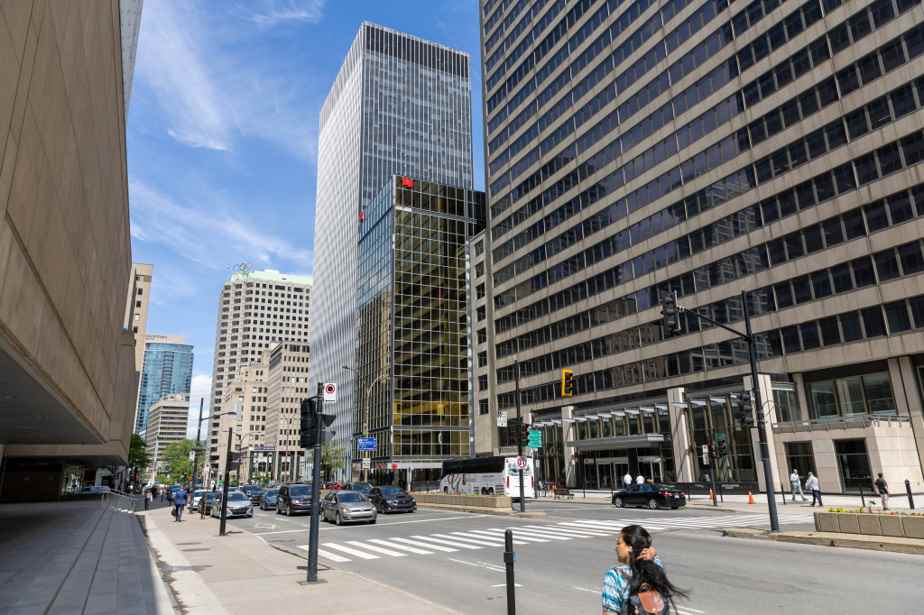The real estate community met Thursday to bury the hatchet with the City of Montreal and to be told that the economy is doing well. However, the situation for office towers is going in the opposite direction. A pessimistic scenario presented by real estate experts sees the availability rate of downtown office towers climb up to 25% by 2027.
Posted at 6:00 a.m.
Decidedly, the office has not finished suffering from the pandemic, even if the workers are quietly returning to the city center.
“There is work to be done to bring people back to the city center,” warned Marie-France Benoit, director, market intelligence for Canada, at the real estate agency Avison Young. She was speaking to an audience of developers at the Montreal Real Estate Summit held at the Palais des Congrès on Thursday morning.
She teamed up with Sylvain Leclair, CEO of Groupe Altus. Together, they painted a portrait of the real estate market in Montreal after two years of pandemic.
In summary, the residential rental sector and the industrial sector are doing wonderfully, while shopping centers and offices are taking the hit.
The office availability rate is currently close to 17% in the city centre. It was below 10% before the pandemic.
An availability rate includes vacant premises as well as other premises immediately available for rental or subletting for which the owner-manager continues to receive rent. In comparison, a vacancy rate is only interested in vacant premises that are not under lease.
A rise in the availability rate is often the prelude to a rise in the vacancy rate.
Contrary to popular belief, Altus experts have found that the quality of offices, A or B, hardly matters: both categories, the newest as well as the oldest, suffer equally from post-COVID symptoms.
Faced with the deterioration of market conditions, downward pressures are intensifying on the level of rents. Effective net rent, what stays in the landlord’s pocket after he has paid taxes, operating expenses and niceties to tenants to convince them to sign the lease, has already started to decline. It’s gone below $14 per square foot… and it’s probably not over.
Mr. Leclair sketched out two scenarios for the next few years based on the popularity of telecommuting. The first provides that the occupants of offices in the city center will free up 20% of the area occupied at the end of their lease. His pessimistic scenario assumes a freed-up area of 30%.
His two scenarios take into account employment growth equivalent to an occupation of 25,000 m2 offices per year. Nevertheless, it will remain clearly insufficient to stop the upward trend in office availability.
According to the first scenario, the availability rate will increase to 21.4% in 2027. The worst-case scenario pushes the availability to 25% of the total office stock in the city centre.
By 2027, National Bank will have taken possession of its new 100,000 m2 and will have abandoned for good the scattered offices in the city center that it currently occupies.
Obviously, Mr. Leclair recalled that these were simulations and that the reality could differ.
The proportion of remote work job offers on the rise
Recent signs, however, suggest that the reality of working from home will survive the pandemic, whatever Elon Musk thinks.
According to an indicator presented by Marie-France Benoit, who scans job offers on sites like Indeed, 15% of jobs posted in the field of financial services are offered by teleworking. In technology, the phenomenon affects nearly 3 out of 10 posted positions. Before the pandemic, only 3% of posted positions in these two sectors were telecommuting.
“Even if the economy is doing well, even if there is job creation, that does not mean that the demand for offices will increase in the same proportions,” explained Mr.me Benoit to his audience.
“The hybrid formula [combinant travail au bureau et en télétravail] is here for good,” added Mr. Leclair.
The good news is that the Montreal economy has resumed its growth. The increase in the number of jobs posted over the past two years in the technology sector amounts to 29%. In Toronto, the jump is 62% and its downtown is not doing much better.
Employment growth is also seen in financial services. The number of job postings has increased by 39% over the past two years in Montreal. On the side of the financial capital of the country, the increase is 43%.
-56%
Decrease in pedestrian traffic downtown since the start of the pandemic on May 23, 2022
AVISON YOUNG VITALITY INDEX

PHOTO PHILIPPE BOIVIN, SPECIAL COLLABORATION
The office has not finished suffering from the pandemic, even if the workers are quietly returning to the city center.
Room for dialogue
At loggerheads since the adoption of the bylaw on diversity (20-20-20), developers and the City of Montreal shook hands at the Montreal Real Estate Summit on Thursday morning.
The Summit had invited Mayor Valérie Plante to address real estate developers on Thursday morning. What’s more, Luc Rabouin, head of economic development on the city’s executive committee, shared the podium during a workshop on collaborative partnerships with Laurence Vincent, president of Groupe Prével.
The poster promised since Mme Vincent had made a noteworthy outing against the City at the end of April during a forum organized by the Chamber of Commerce of Metropolitan Montreal in which Mr. Rabouin precisely participated.
In her speech, the mayor took the trouble to salute the initiative of the promoters who presented last Tuesday a common vision of the development of the Bridge-Bonaventure sector, which, however, is significantly different from the vision proposed by the municipal authorities.
“Densification has its place,” she added. “Height and density, there will be, if we want to build complete living environments,” she continued.

PHOTO DAVID BOILY, THE PRESS
Valérie Plante, Mayor of Montreal
The Mayor also recalled the initiatives implemented by the City to make municipal services more efficient with regard to the real estate industry. The elected spoke of the facilitating cells, a sort of consultation tables responsible for delivering recommendations in this direction in the fall. She also highlighted the establishment of a tactical team, including developers, to find solutions for the construction of affordable housing.
“We have to keep talking to each other,” she agreed.
Expressway
For his part, Luc Rabouin, mayor of the Plateau-Mont-Royal borough, expressed in the workshop his desire to move forward in the fall with the appointment of project managers whose task is to become the City’s sole guarantors for developers. The project manager’s mission would be to diligently guide the project through the maze of municipal bureaucracy.
Mr. Rabouin thus responds to a request from promoters that Laurence Vincent publicly expressed last April.
Alongside Mr. Rabouin on the stage, Lucie Careau, director of the Urban Planning and Mobility Department of the City of Montreal, mentioned the possibility of opening a fast track for the acceptance of small real estate projects, so-called spacers, with the aim of accelerating the delivery of new housing.
Alternately, Mr. Rabouin and Mr.me Careau took advantage of the forum to expose the constraints that the provincial power imposes on cities and which contribute to the administrative delays so decried by the real estate community.
“We have to work together”
The promoters did not remain impassive in the face of this call in good faith for constructive dialogue.

PHOTO DAVID BOILY LA PRESSE, LA PRESSE ARCHIVES
Roger Plamondon, co-president of the Montreal Real Estate Summit
“We have reached a time when we have to collaborate,” said Roger Plamondon, President of the Real Estate Group at Broccolini, one of the city’s major developers and co-chair of the Summit. “There are so many challenges to meet, we all have to work together: the community, the private sector and the City. Recently, we have had very positive signals with initiatives from the City […] We will not always agree, but we should be able to agree on a common core that will allow us to move forward, ”he hopes.
The challenges to which Mr. Plamondon refers concern the housing crisis exacerbated by the lack of new housing and the deterioration of housing affordability due to soaring prices.

